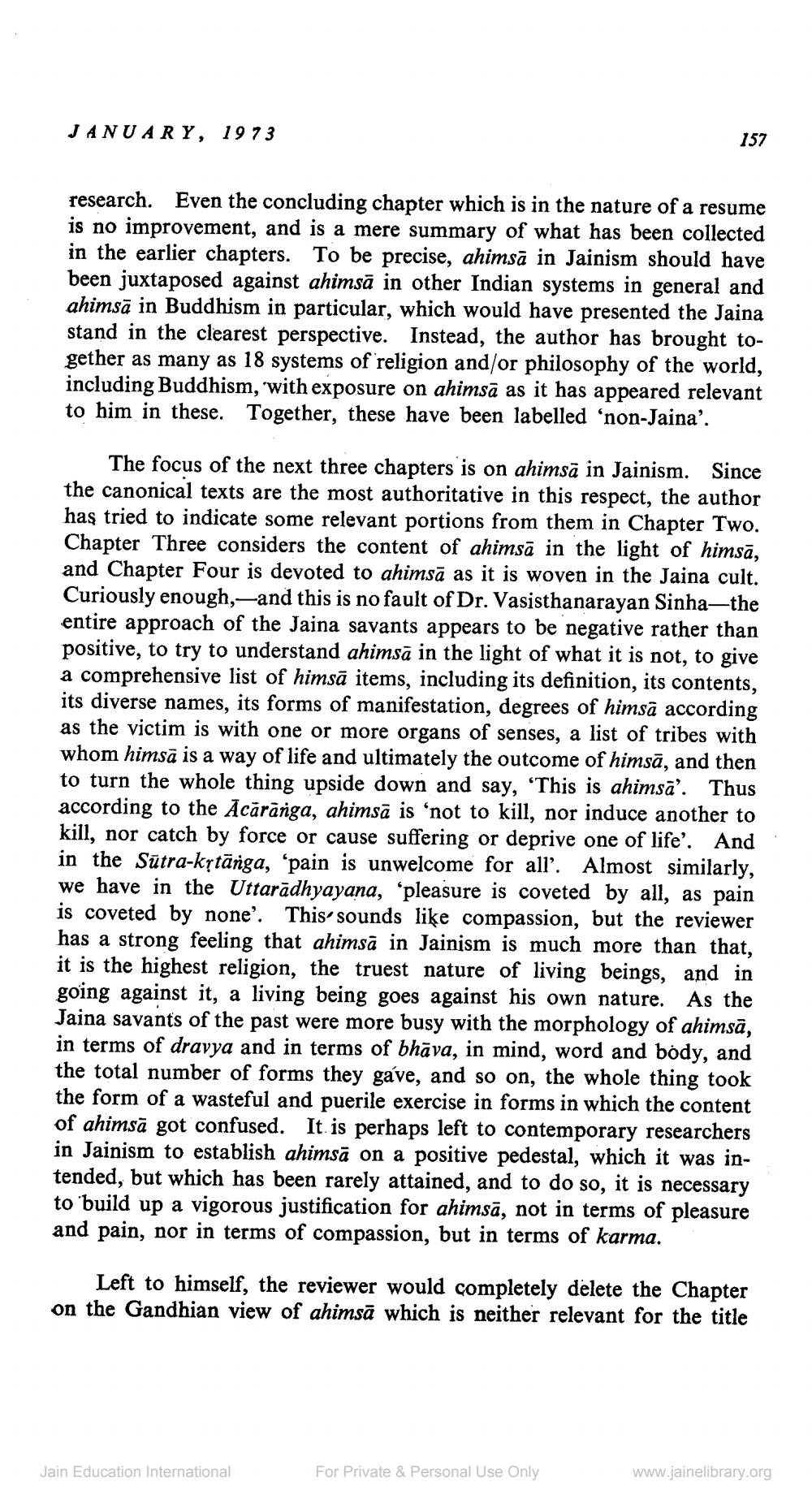Book Title: Jain Journal 1973 01 Author(s): Jain Bhawan Publication Publisher: Jain Bhawan Publication View full book textPage 5
________________ JANUARY, 1973 157 research. Even the concluding chapter which is in the nature of a resume is no improvement, and is a mere summary of what has been collected in the earlier chapters. To be precise, ahimsā in Jainism should have been juxtaposed against ahimsā in other Indian systems in general and ahimsā in Buddhism in particular, which would have presented the Jaina stand in the clearest perspective. Instead, the author has brought together as many as 18 systems of religion and/or philosophy of the world, including Buddhism, 'with exposure on ahimsā as it has appeared relevant to him in these. Together, these have been labelled ‘non-Jaina’. The focus of the next three chapters is on ahimsā in Jainism. Since the canonical texts are the most authoritative in this respect, the author has tried to indicate some relevant portions from them in Chapter Two. Chapter Three considers the content of ahimsa in the light of himsā, and Chapter Four is devoted to ahimsā as it is woven in the Jaina cult. Curiously enough,—and this is no fault of Dr. Vasisthanarayan Sinha—the entire approach of the Jaina savants appears to be negative rather than positive, to try to understand ahimsa in the light of what it is not, to give a comprehensive list of himsā items, including its definition, its contents, its diverse names, its forms of manifestation, degrees of himsa according as the victim is with one or more organs of senses, a list of tribes with whom himsā is a way of life and ultimately the outcome of himsā, and then to turn the whole thing upside down and say, 'This is ahimsā”. Thus according to the Acārārga, ahimsā is 'not to kill, nor induce another to kill, nor catch by force or cause suffering or deprive one of life'. And in the Sūtra-kytānga, 'pain is unwelcome for all’. Almost similarly, we have in the Uttarādhyayana, 'pleasure is coveted by all, as pain is coveted by none'. This sounds like compassion, but the reviewer has a strong feeling that ahimsā in Jainism is much more than that, it is the highest religion, the truest nature of living beings, and in going against it, a living being goes against his own nature. As the Jaina savants of the past were more busy with the morphology of ahimsā, in terms of dravya and in terms of bhāva, in mind, word and body, and the total number of forms they gave, and so on, the whole thing took the form of a wasteful and puerile exercise in forms in which the content of ahimsā got confused. It is perhaps left to contemporary researchers in Jainism to establish ahimsā on a positive pedestal, which it was intended, but which has been rarely attained, and to do so, it is necessary to build up a vigorous justification for ahimsā, not in terms of pleasure and pain, nor in terms of compassion, but in terms of karma. Left to himself, the reviewer would completely delete the Chapter on the Gandhian view of ahimsā which is neither relevant for the title Jain Education International For Private & Personal Use Only www.jainelibrary.orgPage Navigation
1 ... 3 4 5 6 7 8 9 10 11 12 13 14 15 16 17 18 19 20 21 22 23 24 25 26 27 28 29 30 31 32 33 34 35 36 37 38 39 40 41 42 43 44 45 46 47 48 49 50 51 52 ... 60
